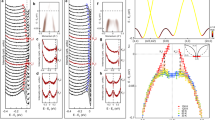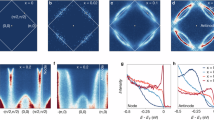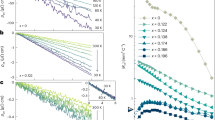Abstract
High-temperature superconductivity in cuprates emerges out of a highly enigmatic ‘pseudogap’ metal phase. The mechanism of high-temperature superconductivity is probably encrypted in the elusive relationship between the two phases, which spectroscopically is manifested as Fermi arcs—disconnected segments of zero-energy states—collapsing into d-wave point nodes upon entering the superconducting phase. Here, we reproduce this distinct cuprate phenomenology in the 5d transition-metal oxide Sr2IrO4. Using angle-resolved photoemission, we show that the clean, low-temperature phase of 6–8% electron-doped Sr2IrO4 has gapless excitations only at four isolated points in the Brillouin zone, with a predominant d-wave symmetry of the gap. Our work thus establishes a connection between the low-temperature d-wave instability and the previously reported high-temperature Fermi arcs in electron-doped Sr2IrO4 (ref. 1). Although the physical origin of the d-wave gap remains to be understood, Sr2IrO4 is the first non-cuprate material to spectroscopically reproduce the complete phenomenology of the cuprates, thus offering a new material platform to investigate the relationship between the pseudogap and the d-wave gap.
This is a preview of subscription content, access via your institution
Access options
Subscribe to this journal
Receive 12 print issues and online access
$259.00 per year
only $21.58 per issue
Buy this article
- Purchase on SpringerLink
- Instant access to full article PDF
Prices may be subject to local taxes which are calculated during checkout




Similar content being viewed by others
References
Kim, Y. K. et al. Fermi arcs in a doped pseudospin-1/2 Heisenberg antiferromagnet. Science 345, 187–190 (2014).
Kim, B. J. et al. Novel Jeff = 1/2 Mott state induced by relativistic spin–orbit coupling in Sr2IrO4 . Phys. Rev. Lett. 101, 076402 (2008).
Kim, B. J. et al. Phase-sensitive observation of a spin-orbital Mott state in Sr2IrO4 . Science 323, 1329–1332 (2009).
Crawford, M. K. et al. Structural and magnetic studies of Sr2IrO4 . Phys. Rev. B 49, 9198–9201 (1994).
Jackeli, G. & Khaliullin, G. Mott insulators in the strong spin–orbit coupling limit: From Heisenberg to a quantum compass and Kitaev models. Phys. Rev. Lett. 102, 017205 (2009).
Kim, J. et al. Magnetic excitation spectra of Sr2IrO4 probed by resonant inelastic X-ray scattering: Establishing links to cuprate superconductors. Phys. Rev. Lett. 108, 177003 (2012).
Fujiyama, S. et al. Two-dimensional Heisenberg behavior of Jeff = 1/2 isospins in the paramagnetic state of the spin-orbital Mott insulator Sr2IrO4 . Phys. Rev. Lett. 108, 247212 (2012).
Jin, H., Jeong, H., Ozaki, T. & Yu, J. Anisotropic exchange interactions of spin–orbit-integrated states in Sr2IrO4 . Phys. Rev. B 80, 075112 (2009).
Wang, F. & Senthil, T. Twisted Hubbard model for Sr2IrO4: Magnetism and possible high temperature superconductivity. Phys. Rev. Lett. 106, 136402 (2010).
Norman, M. R., Randeria, M., Ding, H. & Campuzano, J. C. Phenomenology of the low-energy spectral function in high-Tc superconductors. Phys. Rev. B 57, R11093 (1998).
Mannella, N. et al. Nodal quasiparticle in pseudogapped colossal magnetoresistive manganites. Nature 438, 474–478 (2005).
Uchida, M. et al. Pseudogap of metallic layered nickelate R2−xSrxNiO4 (R = Nd, Eu) crystals measured usingangle-resolved photoemission spectroscopy. Phys. Rev. Lett. 106, 027001 (2011).
Lee, W. et al. Abrupt onset of a second energy gap at the superconducting transition of underdoped Bi2212. Nature 450, 81–84 (2007).
Valla, T., Fedorov, A., Lee, J., Davis, J. & Gu, G. The ground state of the pseudogap in cuprate superconductors. Science 314, 1914–1916 (2006).
Chatterjee, U. et al. Observation of a d-wave nodal liquid in highly underdoped Bi2Sr2CaCu2O8+δ . Nature Phys. 6, 99–103 (2009).
Balents, L., Fisher, M. & Nayak, C. Nodal liquid theory of the pseudo-gap phase of high-TC superconductors. Int. J. Mod. Phys. B 12, 1033–1068 (1998).
Chakravarty, S., Laughlin, R. B., Morr, D. K. & Nayak, C. Hidden order in the cuprates. Phys. Rev. B 63, 093503 (2001).
Affleck, I. & Marston, J. B. Large-n limit of the Hubbard–Heisenberg model. Phys. Rev. B 39, 11538–11558 (1989).
Hashimoto, M., Vishik, I., He, R.-H., Devereaux, T. & Shen, Z.-X. Energy gaps in high-transition-temperature cuprate superconductors. Nature Phys. 10, 483–495 (2014).
Yoshida, T., Hashimoto, M., Vishik, I. M., Shen, Z. X. & Fujimori, A. Pseudogap, superconducting gap, and Fermi arc in high-TC cuprates revealed by angle-resolved photoemission spectroscopy. J. Phys. Soc. Jpn 81, 011006 (2012).
Watanabe, H., Shirakawa, T. & Yunoki, S. Monte Carlo study of an unconventional superconducting phase in iridium oxide Jeff = 1/2 Mott insulators induced by carrier doping. Phys. Rev. Lett. 110, 027002 (2013).
Meng, Z. Y., Kim, Y. B. & Kee, H.-Y. Odd-parity triplet superconducting phase in multiorbital materials with a strong spin–orbit coupling: Application to doped Sr2IrO4 . Phys. Rev. Lett. 113, 177003 (2014).
Keimer, B., Kivelson, S., Norman, M., Uchida, S. & Zaanen, J. From quantum matter to high-temperature superconductivity in copper oxides. Nature 518, 179–186 (2015).
Fradkin, E., Kivelson, S. A. & Tranquada, J. M. Theory of intertwined orders in high temperature superconductors. Rev. Mod. Phys. 87, 457–482 (2015).
Varma, C. M. Theory of the pseudo gap state of the cuprates. Phys. Rev. B 73, 155113 (2006).
Fauqué, B. et al. Magnetic order in the pseudogap phase of high-TC superconductors. Phys. Rev. Lett. 96, 197001 (2006).
Feng, D. et al. Signature of superfluid density in the single-particle excitation spectrum of Bi2Sr2CaCu2O8+δ . Science 289, 277–281 (2000).
Cao, Y. et al. Hallmarks of the Mott-metal crossover in the hole doped J = 1/2 Mott insulator Sr2IrO4. Preprint at http://arxiv.org/abs/1406.4978 (2014).
Brouet, V. et al. Transfer of spectral weight across the gap of Sr2IrO4 induced by La doping. Phys. Rev. B 92, 081117 (2015).
de la Torre, A. et al. Collapse of the Mott gap and emergence of a nodal liquid in lightly doped Sr2IrO4. Preprint at http://arxiv.org/abs/1506.00616 (2014).
Ohta, T., Bostwick, A., Seyller, T., Horn, K. & Rotenberg, E. Controlling the electronic structure of bilayer graphene. Science 313, 951–954 (2006).
Hossain, M. et al. In situ doping control of the surface of high-temperature superconductors. Nature Phys. 4, 527–531 (2008).
Zhang, Y. et al. Direct observation of the transition from indirect to direct bandgap in atomically thin epitaxial MoSe2 . Nature Nanotech. 9, 111–115 (2014).
Cao, G. et al. Anomalous magnetic and transport behavior in the magnetic insulator Sr3Ir2O7 . Phys. Rev. B 66, 214412 (2002).
Kim, J. et al. Large spin-wave energy gap in the bilayer iridate Sr3Ir2O7: Evidence for enhanced dipolar interactions near the Mott metal–insulator transition. Phys. Rev. Lett. 109, 157402 (2012).
Chun, S. H. et al. Direct evidence for dominant bond-directional interactions in a honeycomb lattice iridate Na2IrO3 . Nature Phys. 11, 462–466 (2015).
Yan, Y. J. et al. Signature of high temperature superconductivity in electron doped Sr2IrO4. Preprint at http://arxiv.org/abs/1506.06557 (2015).
Acknowledgements
We acknowledge helpful discussions with C. Kim, G. Khaliullin, B. Keimer, M. Le Tacon, G. Jackeli, J. F. Mitchell, M. Norman and J. W. Allen. We thank B. Y. Kim for technical assistance. The Advanced Light Source is supported by the Director, Office of Science, Office of Basic Energy Sciences, of the US Department of Energy under Contract No. DE-AC02-05CH11231. This work was supported by IBS-R009-D1.
Author information
Authors and Affiliations
Contributions
B.J.K. conceived the project. Y.K.K. and B.J.K. performed the ARPES experiment with support from J.D.D. N.H.S. grew and characterized the single crystals. Y.K.K. analysed the data. All authors discussed the results. B.J.K. led the manuscript preparation with contributions from all authors.
Corresponding author
Ethics declarations
Competing interests
The authors declare no competing financial interests.
Supplementary information
Supplementary information
Supplementary information (PDF 492 kb)
Rights and permissions
About this article
Cite this article
Kim, Y., Sung, N., Denlinger, J. et al. Observation of a d-wave gap in electron-doped Sr2IrO4. Nature Phys 12, 37–41 (2016). https://doi.org/10.1038/nphys3503
Received:
Accepted:
Published:
Issue date:
DOI: https://doi.org/10.1038/nphys3503
This article is cited by
-
Realizing metallicity in Sr2IrO4 thin films by high-pressure oxygen annealing
NPG Asia Materials (2023)
-
Orbital-selective metal skin induced by alkali-metal-dosing Mott-insulating Ca2RuO4
Communications Physics (2023)
-
Engineering metal oxidation using epitaxial strain
Nature Nanotechnology (2023)
-
Electronic nature of the pseudogap in electron-doped Sr2IrO4
npj Quantum Materials (2022)
-
Signature of Kondo hybridisation with an orbital-selective Mott phase in 4d Ca2−xSrxRuO4
npj Quantum Materials (2022)



